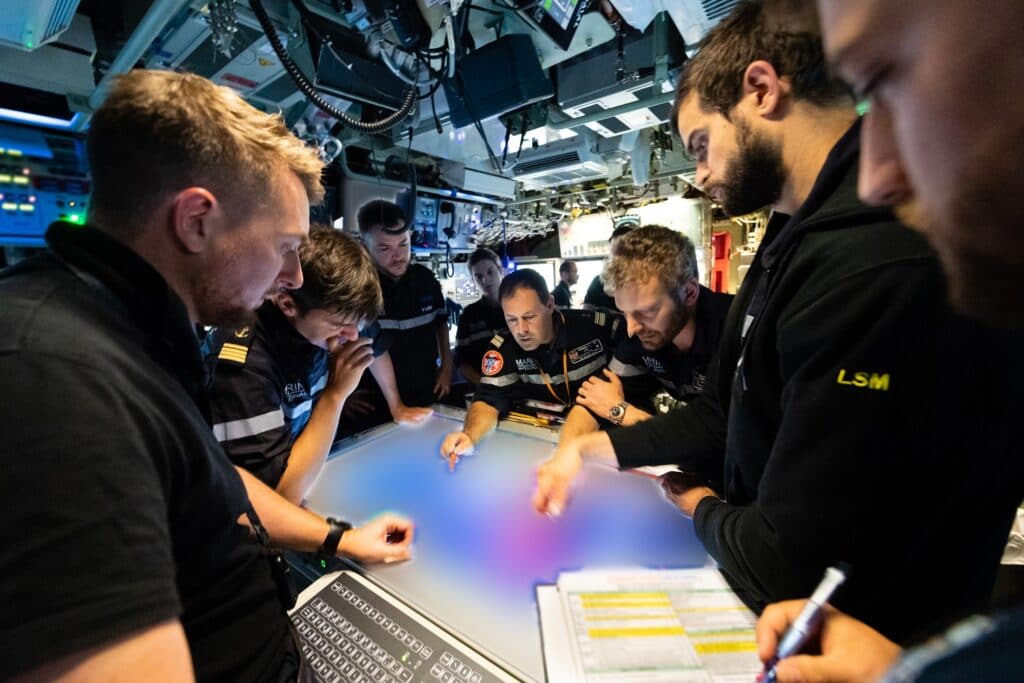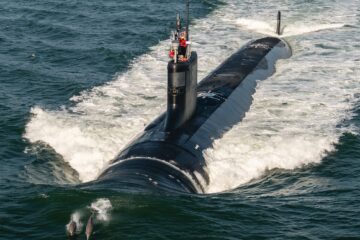We were first welcomed at Toulon naval base by the commander of ESNA (Escadrille des Sous-Marins Nucléaire d’Attaque), the French SSN fleet, Commander Jérôme Colonna d’Istria who introduced the French submarine force.
The force has a total of 3,200 sailors, 1,500 of them serve aboard the SSBNs and SSNs. France currently has four Le Triomphant-class SSBNs, and six attack submarines: five Rubis-class and the first-in-class Suffren.
Commander Colonna D’Istria explained while Suffren was delivered last year, operational missions are still being fulfilled by the 5 remaining Rubis-class SSNs which have now been serving the French Navy for three decades:
“These are submarines that we have kept up to date in a remarkable way and that have reached a significant operational maturity. The participation of the Emeraude in an Indo-Pacific deployment in early 2021 is the most obvious example of that maturity”.
That being said, the arrival of the Suffren-class submarines brings a lot of change for the ESNA.
“The Suffren is more stealthy, brings more endurance and firepower compared to the Rubis-class submarines. All this calls for new developments on our part, new tactics, new know-how which is currently our main focus with the Suffren: We have a lot of experimentation and tactical developments to do […] it is more agile, it is more stealthy therefore it calls for new tactics in all warfare domains”.
Commander Colonna D’Istria

The trials are now in the phase of “validation of military characteristics”. They are currently focusing on the weapon systems: The Suffren comes with two new weapons for the French Navy: The Naval Cruise Missile (MdCN by MBDA) and the F21 heavyweight torpedo by Naval Group. The validation of military characteristics consist in checking if the platform that was handed over last year by Naval Group to the procurement agency DGA meets the military need of the Navy. It is a lengthy process:
“The Suffren already spent more than 120 days at sea so far in 2021, over 3,000 hours dived […] we sailed the boat all the way to the Equator, we were able to evaluate its endurance over several dozen days.”
“The boat already fired about a dozen torpedoes. More firings will be conducted because we are in an incremental development process”“We also validated the lock-out chamber for the naval special forces”.
Naval News also learned that Suffren called at Crete Naval Base (NATO Naval Support Activity, Souda Bay) to validate the submarine’s ability to interface with NATO standard naval bases and berths. The Suffren is set to enter active duty “in the coming months”.
“In terms of displacement, the Suffren-class is double the displacement of the Rubis-class, 5,100 tons compared to 2,600 tons, but at the same time Suffren has a smaller crew (63 compared to 72)”
The Suffren-class SSN is designed to perform in both blue water and littoral areas, and to do so further, longer and with more firepower than its Rubis-class predecessors. It is equipped with a highly automated platform management system and an innovative propulsion system. The Suffren‘s “silent speed” is double that of the Rubis-class SSN.
Another field where Suffren brings a revolution: Maintenance. The new submarine need just one technical stop per year (which lasts about 2.5 months) and may spend over 200 days at sea following these overhaul periods. This is thanks, among other things, to the implementation of predictive maintenance. To accommodate the Suffren-class, new infrastructures (berth, docks, cranes…) are being built at Toulon naval base.
Importance of the ENSM/BPN training faciliy

“For ESNA, the challenge of the decade to come will be to train our 1000 submariners for the new capabilities brought by the Suffren. For this, the key to success is the human resource tool that is the school of underwater navigation”
“One of the great successes of the Barracuda program was to think of this tool well in advance of the boat’s arrival. The simulators were delivered in 2015.”
Commander Colonna D’Istria
We were then shown the facility where French submariners are trained. Located right by the ESNA headquarters, it is the submarine navigation school (ENSM/BPM for école de navigation sous-marine et des bâtiments à propulsion nucléaire). For the past 100 years, this school is training French submarine crews (as well as the personnel in charge of the nuclear power aboard aircraft carrier Charles de Gaulle). Over 600 sailors are trained every year, 20% of them officer grade. The school has 8 full scale simulators which train in the field of nuclear propulsion, platform management and even tactical combat in land attack, anti-surface warfare and anti-submarine warfare (for this, some of the simulators can be network allowing 1 on 1 or cooperative engagement). The school also use virtual reality technology to train the “rondiers” (sailors conducting security rounds, there are 6 of them aboard Suffren-class SSNs) with a fully immersive 3D representation of the submarine. It features interactive knobs and valves. The tool was developed by Naval Group who worked with a video game producer for the visual aspect. The tool is impressive and proves to be very effective with new generation of sailors.
Having access to the advanced simulators so early in advance helped ESNA to not only train the first crews of Suffren on how to operated the submarine, but also to work on the organization inside the submarine, to work on training programs and to start developing new tactics.
Aboard Suffren

It was time to step aboard the Suffren. Commander Antoine Richebé, the commanding officer of Suffren welcomed us. We had to leave our smartphones and smartwatches behind us. The French Navy treats Suffren as a very sensitive asset. We accessed the submarine via a ladder located aft of the sail, in the same area where the lock-out chamber for special forces is located. We then entered the CIC. My main impressions were “space” and “modernity”. I previously had the privilege to step inside only two submarines: HNLMS Bruinvis, a Dutch Walrus-class submarine and HSwMS Södermanland of the Swedish Navy. Both are from the late 1980ies, both are much smaller diesel submarines. Therefore the comparison is not fair: The CIC of Suffren (and generally speaking every compartments aboard) is much more modern and much more spacious (relatively speaking). You really feel you stepped in a next generation and state-of-the-art vessel. Yet, I was naively expecting a fully digital set up. However there are still “good old” manual and physical valve wheels, knobs, pressure gauges a little bit everywhere onboard (expect in the mess, berthing compartments and maybe a lot less, but still present here and there, in the CIC). I was told this was obviously for safety reasons and that “full digital” setups aboard submarines is not likely to happen any times soon…
To give you a good idea of how the CIC of Suffren is, this CGI video is a pretty accurate representation:
The CIC consists features 10 multifunction consoles, plus a central seat for the commanding officer and a large tactile table which can be used for cooperative mission planning, navigation, show footage from the optronic masts…
While all consoles are multifunction and the same (except two which feature joysticks to steer the various masts), the CIC aboard Suffren is organized in the following way:
- Two consoles to the right of the commanding officer (CO) are dedicated to sonars
- One console to the right of the CO is dedicated to the acoustic analyst (the so called “oreille d’or”, French for golden ear)
- The next console on the right is dedicated to the MOAS and terrain following. Fun fact: The CO explained that the French Navy is working on a technology that would allow to submarine crew to precisely identifying their location by analyzing the shape of the bottom of the sea. He showed us on the screen a 3D representation of the sea bottom. This would obviously only work in well documented area but it a big plus in GPS denied environment or if the submarine needs to remain dived for extended periods and can not re-calibrate its INS.
- The final console on the right hand side is dedicated to the optronic masts.
- To the left of the CO is the second console dedicated to the optronic masts.
- Two tactical consoles (including EW)
- One console for weapons engagement
- One console for the F21 torpedo (where the operator can steer the torpedo as long as the optical fiber is still attached to it)

Virtually all the equipment in the CIC is of French origin. I did spot however a “Falcon II” radio by Harris. I enquired about it and the Commanding Officer explained that this radio is needed in specific situations involving NATO or US units because of specific encryption.
Commander Richebé explained that in combat operations, there can be up to 15 sailors in the CIC. Forward of the consoles but in the same “room” are two positions which combine damage control, platform management and “driving of the boat”. We were told that the Suffren is very easy to drive. It is done via two joysticks. One of the helmsman of the submarine is just 19 year old.
We then went into the officer’s mess. It was roomy, modern and very comfortable. We spotted some wifi routers in there and the CO confirmed: There is a private/closed wifi aboard which allows the crew to access key data from wherever aboard the boat. The wifi network also is a security feature allowing to located 24/7 the location of each crew member (via an RFID chip in the sailors uniform). We were then shown a berthing compartment: 6 berth per compartment. There too it “appeared” to be comfortable: Each bunk gets its own light, power outlet and USB port. The USB port gives the sailor access to an entertainment platform where they can watch movies on their free time. Naval Group used a contractor experienced in cruise ship furnishing to design the interior of some of the living quarters such as the messes and berthing compartments in order to increase crew comfort.
Commander Antoine Richebé then took us down one deck (there is a total of 3 decks aboard), and we entered the torpedo room. The torpedo handling system is as follows: 5 rows on two levels on the left and 5 rows on two level on the right (we were standing in between each). While we were aboard there were:
- 1 training torpedo (recognizable by its orange paint)
- 4 black F21 heavyweight torpedo (the CO confirmed those were “live rounds”).
- 4 naval cruise missiles.
- 3 SM39 Exocet anti-ship missiles.
The missiles (both anti-ship and naval cruise missiles) were wrapped in some kind of fabric sleeves. We were told that these were thermal protection necessary because of the fuel of the missiles. Suffren can carry a total of 20 weapon in the torpedo handling system. Commander Richebé added that the maximum load out is 24 if the submarines sails out with pre-loaded torpedo tubes. He confirmed to be that even in this situation, weapons can still be swapped around. “It becomes like a Tetris game and is a bit cramped but it is do-able”.
We were then showed the large fridge (large enough to store 70 days worth of food for the entire crew) and we climbed our way back up to the lock-out chamber compartment. Up to 5 fully equipped “Commando Hubert” operators (the combat divers unit of the French Naval Special Forces) can fit in the chamber. The device can also serve as the aft emergency escape hatch.
About Suffren

Six new attack submarines will form the vanguard of the French Navy (Marine Nationale) for the coming decades. Developed as the Barracuda program, the lead boat of the new class, Suffren, was launched in July 2019 is expected to formally join the fleet next year. The new submarines will offer a massive capability leap over the current Rubis-class boats.
Suffren in numbers:
- Surface displacement: 4,700 tons
- Diving displacement: 5,100 tons
- Length: 99 meters
- Diameter: 8.8 meters
- Maximum depth: > 350 meters
- Speed: > 25 knots
- Armament: naval cruise missiles, F21 heavy-weight wire-guided torpedoes, modernized Exocet SM39 anti-ship missiles, FG-29 mines, D-19 UUV (future development)
- Hybrid propulsion: pressurized water reactor (150MW) derived from the reactors on board the Triomphant-class SSBN and Charles-de-Gaulle aircraft carrier, two propulsion turbines, two turbo generators and two electric motors
- Crew: 63 crew members + approx. 15 commandos
- Endurance: 70 days at sea (or until food supplies run out)
Innovation for naval combat
The Suffren is equipped with numerous innovations that allow it to demonstrate differentiating capabilities in many areas. The French Navy’s new submarine is able to strike deep behind enemy line all while remaining stealthy thanks to the torpedo tube-launched naval cruise missile (MdCN). The integration of state-of-the-art sensors also gives it superior anti-submarine warfare and intelligence, surveillance, reconnaissance (ISR) capabilities. Commander Colonna D’Istria mentioned that the non-penetrating optronic masts (by Safran Electronic and Defense) were a disruptive technology. They bring unmatched high quality (4K) imagery and every sailor in the CIC can access them. Finally, Suffren comes with systems that facilitate the deployment of naval special forces. In particular, the Dry Deck Shelter, a removable deck hangar, allows the deployment of the new PSM3G swimmer delivery vehicle (SDV) and a dozen combat swimmers.

Further, longer, with a smaller crew
The Suffren also brings its share of improvements to the benefit of the 63 sailors who constitute each of its two crews (the French Navy uses a dual crew system for all its submarines and some of its surface ships). Many equipment have been automated, or their use simplified. Living conditions have also been improved, with the sailors gaining in privacy and comfort with more personal space compared to the Rubis-class SSN, as well as a greater number of showers.






